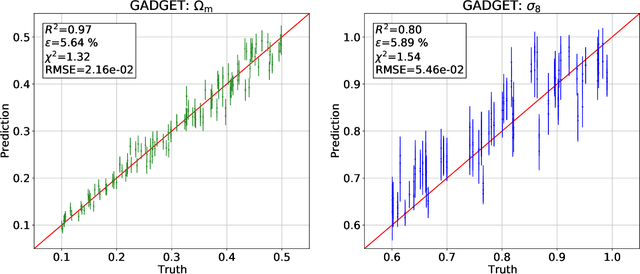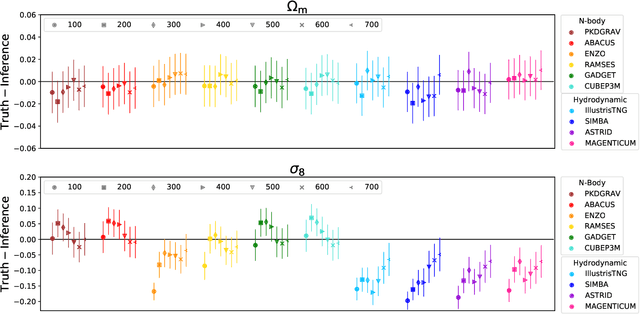Lehman H. Garrison
Robust field-level inference with dark matter halos
Sep 14, 2022



Abstract:We train graph neural networks on halo catalogues from Gadget N-body simulations to perform field-level likelihood-free inference of cosmological parameters. The catalogues contain $\lesssim$5,000 halos with masses $\gtrsim 10^{10}~h^{-1}M_\odot$ in a periodic volume of $(25~h^{-1}{\rm Mpc})^3$; every halo in the catalogue is characterized by several properties such as position, mass, velocity, concentration, and maximum circular velocity. Our models, built to be permutationally, translationally, and rotationally invariant, do not impose a minimum scale on which to extract information and are able to infer the values of $\Omega_{\rm m}$ and $\sigma_8$ with a mean relative error of $\sim6\%$, when using positions plus velocities and positions plus masses, respectively. More importantly, we find that our models are very robust: they can infer the value of $\Omega_{\rm m}$ and $\sigma_8$ when tested using halo catalogues from thousands of N-body simulations run with five different N-body codes: Abacus, CUBEP$^3$M, Enzo, PKDGrav3, and Ramses. Surprisingly, the model trained to infer $\Omega_{\rm m}$ also works when tested on thousands of state-of-the-art CAMELS hydrodynamic simulations run with four different codes and subgrid physics implementations. Using halo properties such as concentration and maximum circular velocity allow our models to extract more information, at the expense of breaking the robustness of the models. This may happen because the different N-body codes are not converged on the relevant scales corresponding to these parameters.
Machine Learning and Cosmology
Mar 15, 2022Abstract:Methods based on machine learning have recently made substantial inroads in many corners of cosmology. Through this process, new computational tools, new perspectives on data collection, model development, analysis, and discovery, as well as new communities and educational pathways have emerged. Despite rapid progress, substantial potential at the intersection of cosmology and machine learning remains untapped. In this white paper, we summarize current and ongoing developments relating to the application of machine learning within cosmology and provide a set of recommendations aimed at maximizing the scientific impact of these burgeoning tools over the coming decade through both technical development as well as the fostering of emerging communities.
 Add to Chrome
Add to Chrome Add to Firefox
Add to Firefox Add to Edge
Add to Edge